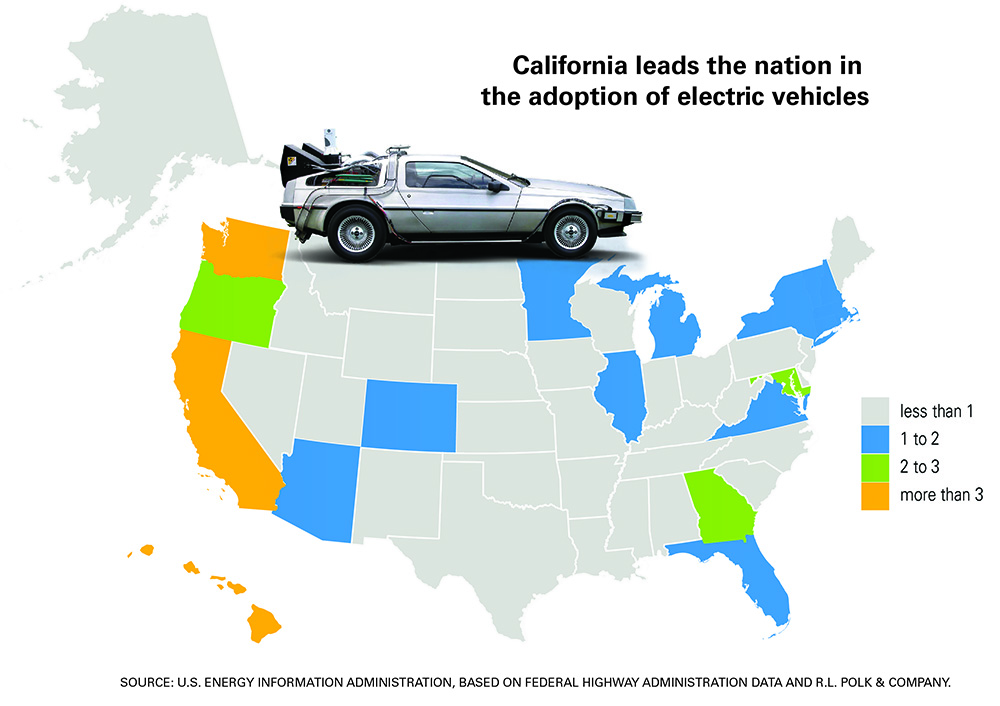Back to the charging station

July 3, 2015, is the 30th anniversary of the Academy Award winning movie, Back to the Future. If you have spent the last 30 years under a rock, you may be unfamiliar with this sci-fi masterpiece.
A brief synopsis: high school student, Marty McFly, is sent back in time in a hot rod DeLorean time machine, discovers his teenage parents, and must get back to 1985.
What is significant to me about this movie is 1. the car (which is awesome) and 2. the sequel (Back to the Future II) takes place in the year 2015. It’s most impressive how Back to the Future II accurately predicts a number of technological changes, such flat panel television sets, the ability to watch six channels at once, Internet video chat, the increase of plastic surgery, hover boards and cars with alternative fuel sources (dubbed Mr. Fusion).
Imagine. The same year that Dodge Durango was produced, a film hit the cinema suggesting powering vehicles with fuel other than gasoline. (Ok, for the nerds out there, technically the DeLorean is a hybrid, but you get my point.) I appreciate how the past (1989) has informed the present.
This brings me to electric vehicles (EV) and charging them on multifamily properties.
Recently, legislation passed in California (AB 2565), which permits residents to install an EV charging station at their cost on your property. You cannot unreasonably deny them. The law does afford the landlord some rights: we may direct residents as to which electrician they can use, which charging stations they can install, require a submeter on the charging station to track electrical use so we can be reimbursed for the electricity when the resident taps into the house panel, etc.
Such a law does compel us to prepare to retrofit our existing properties with EV charging stations. Some of you might say, “well, if as long as I don’t have to pay for it, whatever.” Considering the full ramifications: Who pulls the permit? If the resident decides not to pay the electrician, the lien is against your property, not the resident. What if there is an incident involving the charging station, are you at risk? How do you manage this process? If you have properties in California, it serves you to become versed in this law. Google it.
If you do not have properties in California, consider this. EV sales are rising. If you think that states with growing EV sales will not integrate EV charging on our properties, that might be naïve. Think about how many states are considering legalizing weed now that Colorado has done it successfully. (Yup, I just compared EV charging to weed.) I believe that if AB 2565 is successful in California and increases EV ownership, this law may be cloned in states that, perhaps, you do care about.
The real question we should ask ourselves is “How EV-ready can I be?” When we think about adding EV charging stations to our communities, we should consider what that charger might do to our electrical panels. And are you prepared for a level 2 charging station?
What does level 2 even mean? Think of it as adding an air conditioner to a 3,000-ft. house in a high desert location. I recommend a load study before you pick the perfect spot to install your charging station. What is perfect and what is plausible might not be the same.
Currently there are more than 300,000 electric vehicles are on the road worldwide. With the sticker price on these cars coming down, battery range improving, gas prices rising, and the marketing push of these vehicles increasing, the demand for EV will continue to increase. I know that we have been scratching our collective multifamily heads trying to determine how EV-ready should we be?
Take a look inside your parking structures. Do you have a significant number of hybrid vehicles? If you do, you’re probably attracting a demographic that will want to drive EV’s for a myriad of reasons. While California leads the nation in EV sales (if you have property in this state, look closely), it is important to note that Hawaii, Oregon, Washington and Georgia are rapidly adopting EVs, as well.
In the year 2045, what is today will be the past. Most of us will be even less hip than we are today (and probably crankier). 2015 is our moment to get in sync with the future.
Consider where technology is today, the path we are following, and contemplate how you are going to prep your sites to be ready for that world of tomorrow. How retro will you want to be? Will retro even be considered a good thing? When we get Back to the Future, how EV prepared will we be?
Historical perspective
- March 2024
- February 2023
- July 2022
- March 2022
- June 2021
- February 2021
- August 2020
- February 2020
- July 2019
- April 2019
- June 2018
- April 2018
- October 2017
- May 2017
- November 2016
- June 2016
- November 2015
- June 2015
- September 2014
- June 2014
- April 2014
- December 2013
- July 2013
- December 2012
- July 2012
- October 2011


